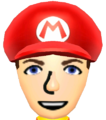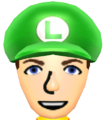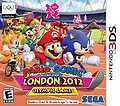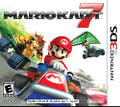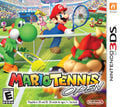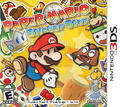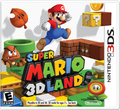Nintendo 3DS: Difference between revisions
No edit summary |
|||
| Line 5: | Line 5: | ||
|Dis=N/A | |Dis=N/A | ||
|Pre=[[Nintendo DS]] | |Pre=[[Nintendo DS]] | ||
|Suc= | |Suc=4DS | ||
|ratings={{ratings|pegi=7|esrb=E}} | |ratings={{ratings|pegi=7|esrb=E}} | ||
}} | }} | ||
Revision as of 09:29, December 20, 2012
Template:System-Infobox Template:LLQuote
The Nintendo 3DS is the successor to the Nintendo DS series of handheld consoles produced by Nintendo. It was released in Japan on February 26th, 2011, Europe on March 25th, 2011, the United States on March 27th, 2011, and Australia on March 31st, 2011. The console has a upper-screen 3D display without the need for glasses (known as autostereoscopy), using parallax barrier technology. The Nintendo 3DS was shown for the public during E3 2010 in Los Angeles, California, coming in metallic colors, its upper screen slightly wider than the bottom touch screen. It costs $169.99 in North America, €169,99 in the Eurozone and £169.99 in the United Kingdom.[1] The 3DS has game cards with a small groove which prevents them from being inserted into an older Nintendo DS. The game boxes are similar in shape but are not as thick. It is of common belief that the Nintendo 3DS is built upon the idea of the Virtual Boy console, discontinued in 1996. The Virtual Boy was able to project a red and black 3D image via the rubber glasses on the console.
The prime feature of the handheld is the 3D display, which is shown in the upper screen of 3.5 inches. The level of 3D depth can be adjusted with a switch found on the right side of the upper frame. The Nintendo 3DS also includes a camera on its inner side located at the top of the upper screen and two outside over the lid, giving the 3DS the capability to take 3D photos, merge pictures, record 3D videos, and play augmented reality games (see below). The handheld has added a a motion sensor, a gyroscope, and a Template:Nobr Pad above the Template:Nobr Pad. Some buttons were moved, such as Select and Start, which are now found currently below the bottom touch screen. The power button is now located below the ,
,
, and
buttons. The
and
buttons have been kept. The new
button allows players to directly enter the system's menu. It is found between the
and
buttons. The handheld also is able to find Wireless Connection spots and other Nintendo 3DS consoles automatically for online play. Online expansion also includes achievements, friend lists, sharing game content with friends, the ability to download new content for games[2] and firmware updates.
Unlike its predecessor, the Nintendo 3DS has the ability to multitask, which can be used by pressing the button. Another feature is the "Tag Mode", in which the handheld detects other nearby 3DS systems automatically even when in sleep mode. Upon turning the power on, the system's Home menu will display several scrollable boxes which act as software apps, each with a different picture for an icon. The player is able to open software by tapping the icon with the 3DS stylus. An inserted game cartridge will appear as a cartridge-shaped icon and will appear as white or grey, depending on which game software. A step counter is also built in, which keeps track of the number of steps the player takes while the power is on and system closed. The 3D top screen will display a moving icon which will appear in 3D when the mode is enabled. If the microphone picks up activity while on the Home screen, the icons on the top screen will react by either spinning or rising up, which will enhance the 3D effect. Additional software can be downloaded via the Nintendo eShop. This can include Virtual Console games.
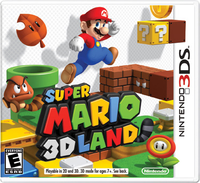
The first game in the Mario series for the 3DS console was released in November 2011 as Super Mario 3D Land, with Mario Kart 7 hitting shelves a month later. The year 2012 has brought upon four Mario games to date, the most recent being Paper Mario: Sticker Star. Luigi's Mansion: Dark Moon is currently in development. A fourth title in the Super Smash Bros. series has been announced as a port to both the Nintendo 3DS and Wii U. The Super Smash Bros., Luigi's Mansion and Paper Mario titles on the 3DS are the first in their respective series to be developed for a handheld console. Super Mario 3D Land is also the first original 3D Mario platformer to be developed for a handheld.
The Nintendo 3DS also has a 2 GB SD card included (though users are free to replace it for a card with more memory), and a charging dock, instead of a charging cable like the Nintendo DS series has. Of course, the charging cable can be used with the Nintendo 3DS, and the cable can be disconnected from the dock and plugged directly into the 3DS. The battery duration is in about three to five hours for playing normal software. However, the higher the brightness setting, the more battery power is used. It depends on what software is running on the 3DS. When communicating with a wireless network connection, the battery tends to consume more power. To fully charge the battery, it takes approximately three hours and thirty minutes.
The system is backwards compatible with both DS and DSi games, although, as with the DSi, Nintendo DS games cannot make use of extensions that used the original DS's Game Boy Advance slot, which the 3DS lacks. Instead the hardware comes with Virtual Console software like the Wii's to download Game Boy and Game Boy Color games. The Nintendo 3DS also has the ability for users to look at some preview videos of games via the eShop. Members of the Nintendo Ambassadors Program received the option of downloading ten classic Mario games from varying Nintendo consoles, four of which are Game Boy Advance games. This promotional offer was rolled out to purchasers of the 3DS prior to the price drop to $169.99, which was active from August 12th, 2011.
The system is currently available in seven colors: Aqua Blue, Cosmos Black, Flame Red, Ice White, Pearl (Misty) Pink, Midnight Purple and Cobalt Blue[3]. Other colors like gold and green shown at E3 2010 have been confirmed,[4] but have not yet been released to the public. A Misty Pink version was released in Japan on October 20, 2011, and an Ice White 3DS (bundled with Super Mario 3D Land) was released in Japan on November 3rd. Club Nintendo Japan and European members have available three exclusive models which are inspired by Mario, Princess Peach and a Super Mushroom.[5] On May 11, 2012, Nintendo of Japan announced that production of the Aqua Blue color of the 3DS will end soon.[6]
The language accessibility has been a primary focus with the Nintendo 3DS. The system is the first Nintendo console to have Portuguese and Russian system language settings. It's also the first Nintendo handheld console to feature a Dutch setting. All these languages are included on the European and Australian version of the 3DS, and the Portuguese language is also included on the American version. Mario games also began being put to Dutch, Portuguese and Russian settings. However, these languages are only available in European and Australian versions of the game. Interestingly the 3DS is the first Nintendo system to be rated by PEGI.
Nintendo 3DS XL
The Nintendo 3DS XL (Nintendo 3DS LL in Japan) is another version of the Nintendo 3DS handheld announced by Satoru Iwata in a Nintendo Direct video on June 22, 2012. Similarly to the Nintendo DSi XL, the 3DS XL has been conceived to have larger screens: The upper measuring 4.88 inches (making it the biggest screen on a Nintendo handheld so far) and the lower measuring 4.18 inches, both being 90% larger than the standard Nintendo 3DS screens. The resolution, however, is the same. The 3DS XL also has been given rounded corners and digital ,
, and
buttons instead of the embedded ones found on the Nintendo 3DS. The handheld also sports a single color job instead of the dual color job of its predecessor (black in the interior of the lid and a second main color overall), although it may also come with dual colors. Additionally, it is packaged with a 4 GB SD card, and the battery has been optimized to last longer. It lasts about 3.5 to 6 hours when playing 3DS games, compared to the 3 to 5 hours of play on the original version. The handheld was released in Japan and Europe on July 28, 2012, in North America on August 19, 2012, and in Australia (bundled with an AC adapter) on August 23, 2012[7]. In Japan and Europe, the handheld does not come with a battery charger, but can use the original Nintendo 3DS's charger. The handheld will have its own charger in North America.[8]
Gameplay Accessories
Stylus
The original 3DS stylus differs significantly from the previous models. It is extendable up to 3.94 inches for the user's comfort. The stylus is stored in a slot on the back of the 3DS system. The stylus on the 3DS XL is non extendable and is stored on the right side of the device.
Circle Pad Pro
The Circle Pad Pro is an extra accessory marketed as enhancing 3DS gameplay controls. As the name implies, it has an extra Circle Pad positioned on the right-hand side coupled with the and shoulder buttons on the back. The whole combination is bundled onto a cradle which fits into the bottom of the 3DS, just as the charging cradle does. Currently, it is only available in Cosmos Black.
Mario Kart 7 Wheel
The Mario Kart 7 wheel is a specially made wheel developed by peripheral manufacturer Hori [9]. The product is marked with the Official Nintendo Seal and fits snugly onto the back of the console. Its function is identical to that of the Wii Wheel. It is currently available in Japan and the UK [10]. Like the Circle Pad Pro, the Mario Kart 7 wheel is only available in Cosmo Black.
3DS Stand
The 3DS stand is a peripheral by Nintendo which holds the 3DS for players while playing any game. It comes bundled with Kid Icarus: Uprising. Included free of charge, the accessory was released alongside Uprising on March 22, 2012 in Japan and March 23 in North America and Europe. It is also available for purchase separately in Japan. The stand will allow the user to have more comfort when playing the game, particularly during sections in which the touch screen is in heavy use. The stand can also be folded down, making it compact and portable to take anywhere the holder goes. Masahiro Sakurai, the director of Kid Icarus: Uprising, stated that the Nintendo 3DS Stand is useful for games that use both the Circle Pad and the touch screen at the same time.
Software
Nintendo 3DS Camera
The Nintendo 3DS Camera is a function that allows users to take photographs and videos in free-glasses 3D. Some photos can have a decorated effect with the in-game tools. Videos can last up to 10 minutes.
Nintendo 3DS Sound
The Nintendo 3DS Sound works similarly to the function previously seen on the Nintendo DSi. Players can record sounds with a duration of 10 seconds and store them in the console or on an SD card. Player can also add music into the SD card and, unlike in Nintendo DSi Sound, the music can be in either MP3 or AAC format. A limit of one hundred music files can be stored in the default folder as well as in any additional folders, though there is no limit to the number of folders that can be created so long as there is enough memory on the SD card. In addition, any recorded sound less than five seconds in length can be attached to a Swapnote.
Mii Maker
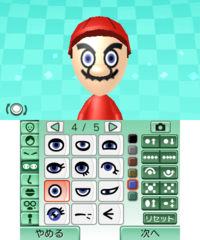
The Mii Channel on the Wii makes a return with minimal changes as Mii Maker. However, there is a new feature in which the 3DS camera takes a photo of the player and converts it to make the photo look like a Mii. Worthy of note is that this feature is not automatic. The player must select the Mii's gender, hair color, and eye color before being prompted to take a picture of either him/herself or another person.[11] The player is then able to leave the Mii as it is or to make any modifications he or she may deem necessary with new customization options (hairstyles, eye shapes, etc.). The player can also connect to his/her Mii Channel and import any Miis found there to the 3DS. To connect the Mii Maker to the Wii, the player must press the ![]() ,
, ![]() , and
, and ![]() buttons on the
buttons on the ![]() when on the Mii Channel. Holding down the
when on the Mii Channel. Holding down the ![]() button for a period of time afterward makes a "Connect to DS" icon appear (if it is not present already).
button for a period of time afterward makes a "Connect to DS" icon appear (if it is not present already).
The player is also able to save their Mii as a QR Code, and save the image to the system's SD card. QR codes can be scanned with the 3DS Camera, and that Mii for that code will be transferred onto that system.
StreetPass Mii Plaza
One of the most notable features of the 3DS, when the player closes his or her 3DS system at any time, even when the StreetPass Mii Plaza is not open, walking past someone else who also has his or her 3DS closed (and StreetPass activated) enables each of the profile Miis to appear in both of their Mii Plazas. A notification light on the 3DS turns green to indicate when another 3DS has been detected.
Also, two games can be played in the Plaza: Puzzle Swap, and Find Mii (called StreetPass Quest outside of North America). In Find Mii, Miis are utilized to fight their way through several enemy-filled rooms. Mario-themed accessories such as character caps can be obtained and later be used to dress up the Miis. When another 3DS is detected, its profile Mii will join in on the game. Players can also hire a wandering hero for two Play Coins, with a limit of up to ten in a single party. However, these heroes are usually very weak (Level 1 or 2) and take the appearance of a dog or a cat depending on the players' preference for cats or dogs (players can choose in their profile).
A sequel to Find Mii, known as Find Mii II (StreetPass Quest II outside of North America), was made available in the October 2011 system update. It is similar to the original, but features tougher challenges. It can only be played once the first Find Mii game has been cleared two times.
In Puzzle Swap, there are a number of different puzzles, each of which can be completed by collecting all of its pieces. Once a puzzle is completed, a three-dimensional image of the puzzle can then be viewed. Players are given one piece to start off with, and more can be obtained by StreetPassing with other people. After StreetPassing with someone, the player is then entitled to take a puzzle piece from them (and vice versa) and add it to their collection. If another player does not have any new pieces, nothing is gained. Players can also spend two Play Coins to buy a random puzzle piece to any incomplete puzzle they have. However, the puzzle piece may be a copy of any earlier acquired pieces, and will be of no use.
While the initial puzzles consisted of fifteen pieces, the October 2011 update included several more larger puzzles with either twenty-four or forty pieces. Additionally, the four centermost pieces in the twenty-four piece puzzles and the eight centermost pieces in the forty piece puzzles are pink. These pink pieces cannot be purchased with Play Coins, and can only be obtained by StreetPassing other people who have them.
Find Mii Mario-themed Accessories
Find Mii II Mario-themed Accessories
New accessories were included with the October 2011 system update:
- StreetpassYoshihat.JPG
Yoshi Hat - StreetpassYellowYoshiHat.JPG
Yellow Yoshi Hat - StreetpassPiranhaPlanthat.JPG
- StreetpassWarppipehat.JPG
Warp Pipe Hat - StreetpassDonkeyKonghat.JPG
Donkey Kong Hat - StreetpassDaisy'sCrown.JPG
Daisy's Crown - StreetpassWaluigiCap.JPG
Waluigi's Cap - StreetpassQuestionmarkHat.JPG
Question Block Hat
- Light Blue Yoshi Hat
- Pink Yoshi Hat
- Boo Hat
- Chain Chomp Hat
- Blooper Hat
- Shy Guy mask
- Wario Hat
- ? Block hat
- Waluigi hat
- Peach's Crown
- NES Hat
- 3DS Hat
- Famicom Hat
Mario-themed Puzzle Swap Panels
- Mario and Bowser (15 pieces)
- Super Mario Galaxy 2 (15 pieces)
- New Super Mario Bros. Wii (15 pieces)
- Super Mario 3D Land (40 pieces)
- Mario Kart 7 (40 pieces)
- Donkey Kong Country Returns (24 pieces)
- Mario Tennis Open (40 pieces)
- New Super Mario Bros. 2 (40 pieces)
Augmented Reality Games
- Main article: Augmented Reality Games
The system is released with a total of six AR Cards that are used primarily in this feature, having a minor role in Nintendogs + Cats, among other games. In Nintendogs + Cats, using the Mario AR Card enables the player's pets to wear Mario-related hats. The Question Block Card can be used to play games, while the five Character Cards included can be used to take 2D or 3D photos.
The 3DS camera is required to play the games, as it must be aimed at the AR Card at all times to read it. Upon reading the Question Block Card, a menu of games appears, including Archery (Shooting in Europe), which uses the aiming reticule that is used to open the AR Games, AR Shot, in which the player uses a snooker stick to hit a ball onto a teleporter, Mii Pics, in which the player can take a picture of his or her Mii, Star Pics, which is the same as Mii Pics, but the player uses one or more of the Character Cards, Graffiti, a drawing apparatus, and Fishing, in which the player uses a fishing line to catch fish.
There is also a shop which is unlocked after playing any three of the games, in which the player can buy new features and games using Play Coins.
Face Raiders
Face Raiders is a built-in game for the 3DS that utilizes the 3DS cameras, which is required to make enemies in this game. At the first playthrough, only the inner camera can be used to take pictures of the players' faces. After their first playthrough, players may utilize the outer cameras to take pictures of other people's faces, or they can take another one of their own face by swapping the inner and the outer cameras. If desired, a player can even use a face from a photograph, even if it is online.
The objective of this game is to shoot down floating heads of whatever face picture is taken. The game uses the gyroscope and the outer cameras to play, which makes players shoot down faces while rotating their bodies. It also appears as if they are shooting faces in their current location. New levels can be opened after players complete a level; three levels are unlocked by this method. Each level has its own set of enemies with different attack patterns. Butterflies and bombs appear; butterflies restore HP while bombs give users a chance to blow up all enemies on the screen.
At the end of a level, a boss fight ensues. Players must exploit the weak point of a boss to defeat it. All bosses have different weak points and different methods of attacking. After the boss is defeated, the player completes the game.
- FaceRadierBoss1.JPG
The first boss using Luigi's head.
- FaceRaiderBoss2.JPG
The second boss using Wario's head.
- BBfaceraiders.JPG
The third boss using the head of famed game show host Bob Barker.
- Mariofaceradr.JPG
The final boss using Mario's head.
Nintendo eShop
The Nintendo eShop (initially called Nintendo 3DS Shop) is a feature that allows players to buy Virtual Console and DSiWare titles for their Nintendo 3DS with Nintendo 3DS prepaid cards or credit cards. It also allows Game Promotion. The eShop is similar to Wii Shop Channel and was released with a firmware update on the evening of June 6th, 2011 in North America and on June 7th in other regions such as Japan, Europe, and Australia together with the Internet Browser. At GDC 2011, it was also announced that "3D Classics" would be made available for download in addition to the regular titles (Game Boy, Game Boy Color, and NES titles). These games, while 3D-compatible, retain their original graphical styles, however. Other than purchasing Virtual Console and DSiWare content, users can view information on current and upcoming 3DS titles (most notably through monthly episodes of Nintendo Show 3D, which provides footage of and commentary on popular or notable releases) as well as the Staff Pick of the Week (a Virtual Console or DSiWare title). If desired, users can also purchase and play a variety of "Quick Plays," including popular games such as Bejeweled and Solitaire. Continuing a practice established on the Nintendo DSi, content purchased from the eShop is transported to the 3DS Menu in the form of a gift that must be unwrapped before use. In addition, users are able to purchase downloadable content for their existing games.
Nintendo Zone
Nintendo Zone is a feature that enables users to, once in participating public locations, view screenshots, watch 3D videos, download and play game demos, access the eShop, play compatible games online, browse the Internet, and receive SpotPass content.[12]
Notepad
The Notepad tool allows players to use up to 16 panels to make annotations or make simple drawings while other applications are suspended. Only a pencil option and an eraser option are available, though users can switch the pencil color between black, blue, and red. Any annotation can be saved and stored in the Nintendo 3DS Camera.
Friend List
From the Friend List, players can see their own friend codes and manage the register of other Nintendo 3DS owners they have added as friends. If their friends have the wireless feature of their consoles turned on, users can see the last game they were playing or the last application they were using. If friends play a game that has online capability, such as Mario Kart 7, and users own the same game, then users can join that game and play alongside their friends.
Notifications
Notifications provide users with various alerts that can be received while the console is in sleep mode. When an alert is received, the notification light, located on the front of the console near the button when closed and between the two screens when open, glows a certain color depending on the alert. If the alert is SpotPass-related (e.g. news or a software/application update), the light glows blue, and a blue circle appears on the software/application/feature that sent the alert. If the alert is StreetPass-related, it glows green, and a green circle appears on the software/application/feature. If one of a user's friends registered in the Friend List is online, the light will glow orange (it will flash orange if one of them is playing a game the user can join), and an orange circle appears on the Friend List icon. Finally, if the console's battery is close to being depleted, the light will glow red and flash.
Internet Browser
The Internet Browser uses the Yahoo! and Google search engines; users can choose which of the two to use at any time. The browser used is Netfront Browser NX. Users can type queries into a search bar or click the URL option to type in a web address. The Touch Screen is used to scroll through pages, which are divided between the top and bottom screens. While it does support a variety of web standards (HTML 4.01, XHTML 1.1, CSS 1, CSS 2.1, CSS 3 (some), DOM Levels 1-3, ECMAScript, XMLHttpRequest, and Canvas element (some)) and image formats (MPO, GIF, JPEG, PNG, BMP, and ICO (some may not be displayed)), the browser does not support any type of plug-in (e.g. Flash).
Step Counter
The Step Counter works by using the 3DS's motion sensor to count the player's steps when the 3DS is closed. Every 100 steps gives the player one Play Coin, which can be used in the AR Games, StreetPass Mii Plaza, and compatible games (e.g. Super Street Fighter IV 3D Edition). Players can receive a maximum of ten Play Coins per day and can hold a maximum of 300 on the 3DS system. Additionally, every step is logged in the Activity Log.
Downloadable software
Nintendo Video
Nintendo Video is a free downloadable application that enables the 3DS to display videos in 3D. Using the SpotPass feature, players can receive and view movie trailers, comedy clips, and music videos, all specially selected for their 3D functionality.[13] It is currently available in Japan, Europe,[14][15] and North America. Like the eShop, the service updates regularly. Users can have a maximum of four videos at a time, one of which is deleted with every update. However, starting October 20th, 2011, Nintendo released previously deleted videos on the eShop in North America, where they can be purchased as permanent additions to the 3DS menu.[16][17]
Swapnote
Swapnote (called Nintendo Letter Box outside of North America) is a free, downloadable messaging service that allows users to write notes (up to four pages) via the stylus and send them by either SpotPass or StreetPass to people registered in their Friend Lists (in the case of StreetPass, notes can be given to people who may not be on said list). Users can reply to each note once, and replies are restricted to one page. As users send notes to their friends, they gain access to a variety of features, including the ability to attach photos stored in an SD card, to create messages and art displayed in full 3D, to change the stationery on which notes are written, to view notes in a slide show format, and (using 15 Play Coins) to attach sound recordings from the Nintendo 3DS Sound application. The software can store a combined maximum of 3,000 notes and replies, and each note can have a maximum of 100 replies attached to it, with new notes/replies replacing old ones once this limit is reached (notes given "Favorite" status are not deleted, though replies are). The software is available in Japan, Europe, and North America. An update for this software was released on July 5, 2012[18] in Japan, Europe and Australia which adds the feature to change the ink's colors by pressing either to the right or left, with North America receiving the feature shortly afterward.
Mario-themed stationary
Occasionally, in the wake of an important event, such as a Nintendo Direct broadcast or a game release, special notes are sent via SpotPass by Nintendo employees. Here are some of the currently available Mario-themed stationeries:
Nintendo Direct with Super Mario Bros. sprites
New Super Mario Bros. 2 (American version)
Mario games in development
References in Mario games
- A Cosmo Black 3DS appeared at one of the sketches in the opening of Mario & Sonic at the London 2012 Olympic Games, used as a fun factor (showing the addiction of games).
Health Warnings
The stereoscopic 3D effect provided by the 3DS has been subject to concern among consumers, forcing Nintendo to place a 7+ label on the system, the first in Nintendo system history. Warnings are given elsewhere, including advice on "taking a break once in awhile" within actual games. To reduce disorientation from the 3D, the effect can be adjusted with the slider or even turned off altogether. Parents can lock the 3D, preventing children from using it unless a password is provided. At a Nintendo World Toy Store event near launch of the 3DS, Nintendo provided a warning saying that the 3DS's 3D mode should not be used by children six years and under. As a result, the employees at the event forced young children to play demos exclusively in 2D and even enforced this rule by having parents stick a special sticker featuring Toad on their children before allowing them to play. Later on, this act was justified as a means of providing information and protecting the system against lawsuits.[19]
Media
Gallery
System gallery
Game gallery
- Luigis Mansion dark moon boxart.png
- NSMB2boxcover.jpg
References
- ^ .Nintendo 3DS price - £229.99 at GAME and HMV - Official Nintendo Magazine
- ^ 3DS To Feature Expanded Online; Achievements, Friend Lists
- ^ Nintendo Releasing Cobalt Blue 3DS
- ^ 3DS Gallery
- ^ Club Nintendo Japan - Nintendo 3DS Mario Models
- ^ Nintendo Phasing Out 3DS Aqua Blue
- ^ [1]
- ^ IGN - Nintendo reveals 3DS XL.
- ^ http://www.amazon.com/HORI-Nintendo-3DS-Mario-Racing-Wheel/dp/B0061YFZDQ
- ^ http://www.eurogamer.net/articles/2011-11-29-mario-kart-7-3ds-steering-wheel-confirmed-for-uk
- ^ http://www.youtube.com/watch?v=m7QMPkWptmw
- ^ http://www.nintendo.com/3ds/built-in-software/#/12
- ^ http://www.nintendo.com/3ds/built-in-software/#/10
- ^ http://www.ntower.de/News/21402-Nintendo-Video-erscheint-am-13-Juli-PM/
- ^ [2]
- ^ http://www.nintendo.com/3ds/nintendo-video/
- ^ http://www.joystiq.com/2011/10/20/nintendoware-weekly-nintendo-videos-for-sale-double-dragon/
- ^ http://www.nintendolife.com/news/2012/07/letter_box_update_adds_coloured_ink
- ^ http://andriasang.com/comt81/iwata_defends_3d_warning/

